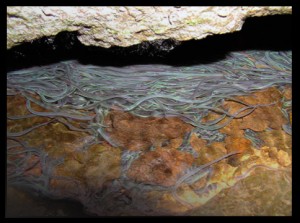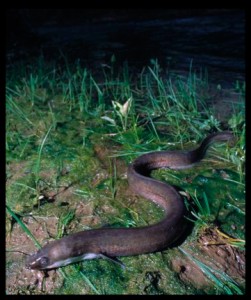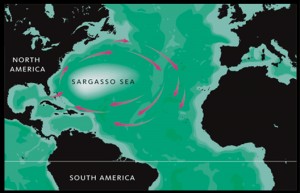 The European eel illustrates exactly why Charles Darwin’s theory of evolution has continued to be on the wrong side of science. Darwin once argued that.
The European eel illustrates exactly why Charles Darwin’s theory of evolution has continued to be on the wrong side of science. Darwin once argued that.
“By the theory of natural selection, all living species have been connected… So that the number of intermediate and transitional links, between all living and extinct species, must have been inconceivably great.”
Since the publication of The Origin of Species in 1859, Darwin’s “inconceivably great” number of evolutionary transitional links in the fossil record over the past 150 years remains missing despite the vast discovery of fossils.
The eel, sometimes referred to as a living fossil, highlights the unique and bizarre novelties of nature rather than Darwin’s concept of an endless series of transitional links. More importantly, rather than serving as an example of evolution, eels, specifically the European eel, now face extinction, not evolution. Darwin, once again, proved wrong.
Perplexing Intrigue
Anguilla anguilla, the scientific name for the European eel, is a snake-like fish species of eel first classified by Swedish biologist Carl Linnaeus in 1758. The eel had long been an intriguing European folklore mystery; however, since fishermen could never catch a baby eel, and spawning had never been observed, it was a mystery. Even more perplexing, no male eel had been identified.
Working at an Italian marine laboratory in Trieste during the summer of 1876, Sigmund Freud, best known as the founding father of psychoanalysis, dissected hundreds of European eels in an attempt to identify the male gonad and to throw some light on its mysterious reproduction and life cycle. Freud, however, failed to identify any male organs in any of the eels he dissected that summer. After three months of frustration, Freud abandoned the research.
Not until the early 1900s did Danish researcher Johannes Schmidt identify the region of the Atlantic known as the Sargasso Sea as the most likely spawning grounds for the European eel. The Leptocephalus (meaning “slim head”) is the flat and transparent larva of the eel that eventually leaves the Sargasso Sea, migrating 4,000 miles towards Europe over a period of 300 days.
Life Cycle
Differing from most fish larvae, Leptocephali (pictured above) grow to much larger sizes with long larval periods from about 3 months to more than a year. Unlike other migrating fish, the European eel is a catadromous fish, meaning its life cycle begins in the saltwater but spends most of its life in freshwater, returning to the sea to spawn and then die.
Freud failed to identify male sex organs in the European eel, not surprisingly, since we now know that sex determination in mature eels is one of the most far-fetched in any vertebrate. Differentiation is determined by environmental factors that are still not entirely understood.
Extraordinarily enough, we now know that in some places, the number of males vastly outnumbers the females, while in other areas, the females outnumber the males. In some studies, eels furthest from the sea tend to be females, and those nearest the sea, males. Both sexes pass through successive phases of neutrality and juvenile hermaphroditism before finally becoming definitely male or female.
The European eel life cycle is as eccentric as its sexual development. Although the juvenile stages had been familiar and profitable to fishermen for centuries as small, transparent, ribbon-shaped fish [pictured], it was not until researchers first observed their transformation into recognizable eels in aquariums in the 1890s that these larval forms were considered entirely different species.
 Sargasso Sea
Sargasso Sea
Over a period of 25 years, between 1905 and 1930, heroic efforts by Johannes Schmidt convincingly showed that the Leptocephali most likely originated from spawning in the warm waters of the Sargasso Sea generated by the North Atlantic Equatorial Current off the east coast of the United States. However, no one has yet observed mating and spawning in the wild.
Nearing the European coast, they lose their sharp juvenile teeth and stop feeding; the anus migrates from a subterminal position to the abdominal midpoint, and they lose skin pigment, metamorphosing into the well-known cylindrical glass eels, or juvenile elvers [pictured above], collecting in vast numbers in the estuaries and river mouths of western Europe.
Migration

In the autumn, the elvers begin their familiar migration in countless numbers up the European rivers, gradually losing their glass-like appearance as color starts to reappear in their skin and they take on the more familiar appearance of young eels. During this migration, they may travel by wiggling across wet grass and digging through damp sand to reach upstream headwaters and ponds. Eventually, every river and a small body of water in western Europe became colonized.
Over the following years, they grow to a length of up to 2 ½ feet in females, a little over a foot in males, and develop a golden pigmentation, hence the name “yellow eels.” Males remain in the rivers for about six years before returning to the sea, while females stay for about nine years.
Return Journey
Mature European eels begin their migration back to the Sargasso Sea in July. On leaving for their return journey, their gut degenerates. They stop feeding. Their eyes enlarge; their eye pigments change for optimal vision in dim, blue, clear ocean light. Their skin lightens on their sides and ventral surface and darkens on their back to create a counter-shading pattern, making it difficult for predators to see them during their long open ocean migration.
How they navigate the journey back to the Sargasso Sea without feeding and against the current remains unknown. To date, no adult eel has ever been followed from the European shores back to the Sargasso Sea. A natural mechanism for such an extraordinarily roundabout way of reproducing is mystifying.
No adaptive transitional links, as Darwin once theorized, stemming from normative fish reproductive habits to such a grotesque life cycle are known. Darwin was simply wrong. Grasping the adaptive significance of sexual metamorphoses continues beyond the realm of science.
Evolutionary Dilemma
The array of evolutionary dilemmas surrounding the European eel further undermines the credibility of the evolutionary industry. Just for the European eel, issues that remain unknown to satisfy Darwin’s theoretical decree includes determining the selective pressures leading the adult eels to dissolve their guts and stop feeding to make the journey back to the Sargasso Sea, migration of the anus from the tail to mid-abdomen during the final stages of larval maturation, why males stay in Europe for six years and females for nine before returning to the ocean. The selective advantage eels achieve by making the transition from salt to freshwater.
“I think it would be hard to invent a story more difficult to comprehend in terms of cumulative selection,” opined Michael Denton in his recent article “Evolution, A Theory in Crisis Revisited,” commenting on the European eel.
In recognition of the spectacular array of genuinely original novelties in the European eel, Denton reflects on the now obvious challenge for the evolution industry:
“It is widely acknowledged that explaining how novelties [in general] arise is one of the key problems that evolutionary biology must address.”
Extinction, Not Evolution
Today, the European eel faces extinction, not evolution. In 2010, the IUCN placed the European eel on the critically endangered “Red List.” Since the 1970s, the number of eels reaching Europe has declined by over 90%. Darwin’s dilemma intensifies.
Genesis
The astounding life cycle of the European eel exemplifies why Darwin was wrong then and is still wrong now. While the scientific evidence continues to undermine the concept of biological evolution, it is compatible with the Genesis account written by Moses.
Evidence from the behavioral sciences to validate the theory of evolution scientifically remains speculative.
The European Eel Challenge is a Behavior article.
Darwin Then and Now is an educational resource on the intersection of evolution and science, highlighting the ongoing challenges to the theory of evolution.
Move On
Explore how to understand twenty-first-century concepts of evolution further using the following links –
- The Understanding Evolution category showcases how varying historical study approaches to evolution have led to varying conclusions. Subcategories include –
- Studying Evolution explains how key evolution terms and concepts have changed since the 1958 publication of The Origin of Species.
- What is Science explains Charles Darwin’s approach to science and how modern science approaches can be applied for different investigative purposes.
- Evolution and Science feature study articles on how scientific evidence influences the current understanding of evolution.
- Theory and Consensus feature articles on the historical timelines of the theory and Natural Selection.
- The Biography of Charles Darwin category showcases relevant aspects of his life.
- The Glossary defines terms used in studying the theory of biological evolution.



